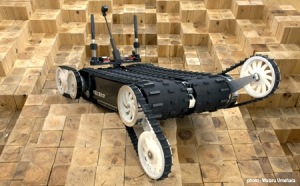Snake like and wheeled robots have been deployed by the leading rescue robotics experts in Japan to help the emergency responders to search for survivors of the tsunami and the devastating earthquake that hit the country last week.
 Japan's earthquake will be a major test for search-and-rescue robots like Quince, developed by Chiba Institute of Technology roboticists, shown here during a demonstration.
Japan's earthquake will be a major test for search-and-rescue robots like Quince, developed by Chiba Institute of Technology roboticists, shown here during a demonstration.
Two teams have plans of using search and rescue robots. One team would be deploying the robots in Sendai and another team in Tokyo. There are also plans of a third team in Tokyo but so far there has been no mention of robots at the troubled Fukushima nuclear power plants. It has been confirmed by Dr Robin Murphy who is one of the top experts in rescue robotics in the world and the Director of the Center for Robot-Assisted Search and Rescue (CRASAR) at the Texas A&M University that, of the two teams one team is being led by Tohuku University’s Satoshi Tadokoro in Sendai and another team is led by Eiji Koyanagi who is from the Chiba Institute of Technology’s Future Robotics Technology Center.
According to Dr Murphy, Dr Tadokoro is proceeding towards Sendai with the Active Scope Camera, which is a remote snake like robot, 8 meters long with a scope camera in it, which could slither in and out of small spaces. She mentions that this robot is one the most competent robot for working via small spaces. In Tokyo, Dr. Koyanagi would be using an agile robot named Quince, which is capable of driving over rubble, has tank like tracks and can climb stairs. Dr. Murphy who is a Fellow of IEEE, whose team has used robots in disaster sites in New York (World Trade Center) and when Hurricane Katrina hit New Orleans reveals that these robots have been used in the 2010 Haiti earthquake. The Engineers in the US Army Corps have used a SeaBotix, remotely operated vehicle (ROV) underwater for investigating seawall and bridge damages. She discloses that for disasters like the Japan quake many robots could prove to be useful such as snake robots, which could enter collapsed buildings and also move thorough rubble; small unmanned aerial vehicles like robotic quadrotors and helicopters for inspecting upper levels of the buildings and also checking the lower altitudes; sensor packed wheeled robots, which are tether-based and unmanned and can remotely drive to search for survivors; and small ROVs, which could work underwater for inspection of bridge and help in underwater recovery.
When the earthquake hit Japan, Dr Tadokoro with a team of 21 faculty and students were in the US taking part in a workshop organized by CRASAR and rushed back to Japan on hearing the news. Dr. Murphy and her volunteer search and rescue robotics team, Robotics Without Borders, which is a CRASAR initiative, states that she and her team are on standby waiting for a formal request from the Japanese Government. CRASAR contains a full fledged robotic arsenal consisting of iSensys helicopters, AirRobot, an AEOS water vehicle, which includes a sonar suitable for bridge inspection, a VideoRay ROV for inspection under the water and also many ground robots such as the Inuktun VGTV, which is a tracked vehicle with a capacity to change its shape.
Most search and rescue robots are designed to reach places where humans cannot access easily and with robots such as the Active Scope Camera, a snake like robot covered by cilia, which are tiny filaments that vibrate and permit the robot to crawl with a speed of 4. Cms/sec, follow walls, climb over barriers and turn in tight spaces; and also the Quince, which is a mobile robot with four sets of tracked wheels to negotiate obstacles and comes equipped with a camera and carbon dioxide and infrared sensors for detecting survivors trapped under the rubble and location of survivors should be easier and quicker.